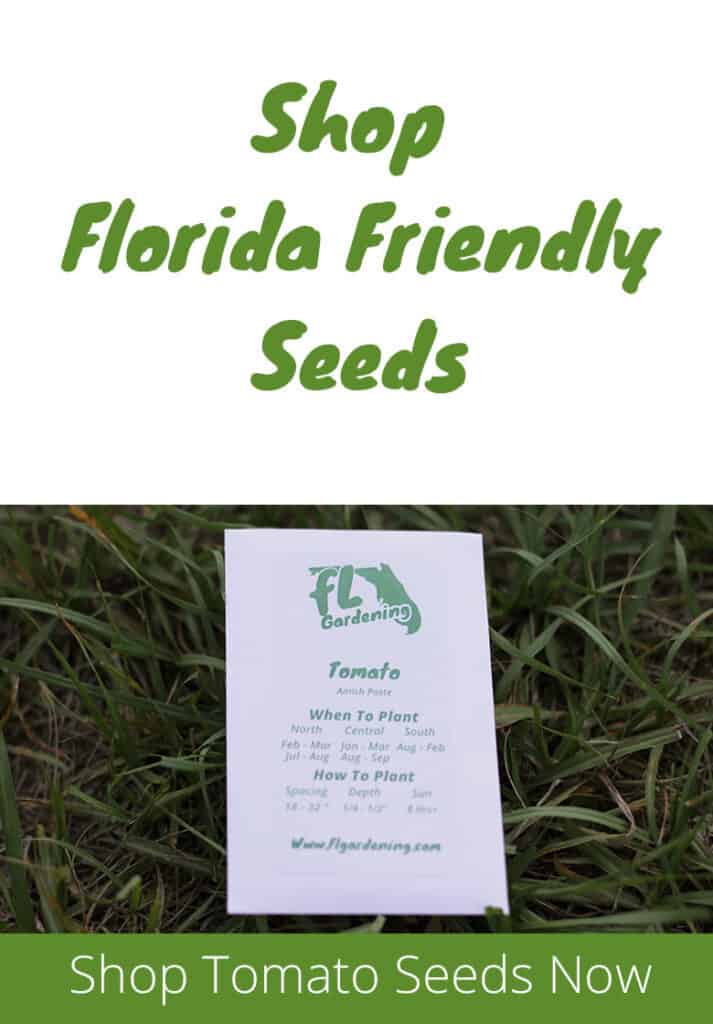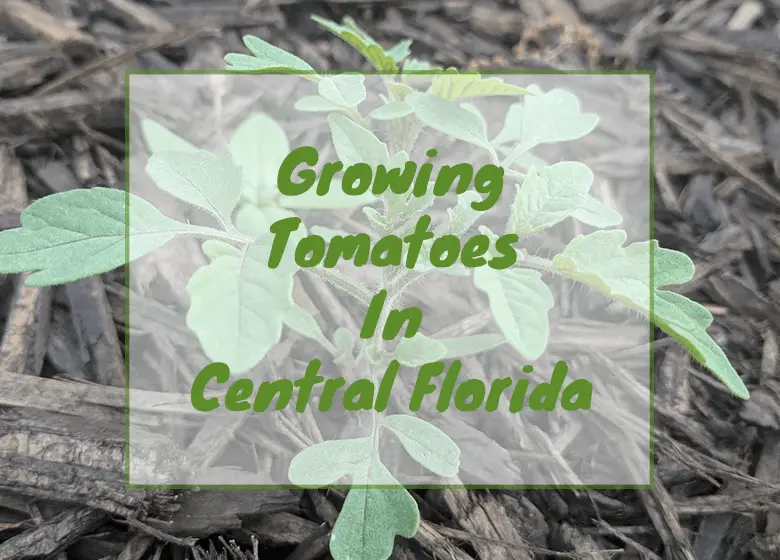
Growing tomatoes in central Florida has been a confusing, angering and fun journey for me. I’ve found a few important things that I think will help your tomato growing attempts.
You need to plant the right variety, at the right time and in the right spot. It’s not that hard to nail these things down with a few bits of basic knowledge.
- Florida friendly varieties – Everglades, Better Boy, Floragold or Celebrity.
- Best time to plant – Once in March and once in August
- Best Place to plant – Anywhere that gets 8 hours of sun and can be watered easily.
Knowing this tiny bit of knowledge gives you a huge advantage.
Also, I’ll let you know how I’ve had success growing tomatoes with fertilizer schedules and give you some common pests to look out for and how to take care of them.
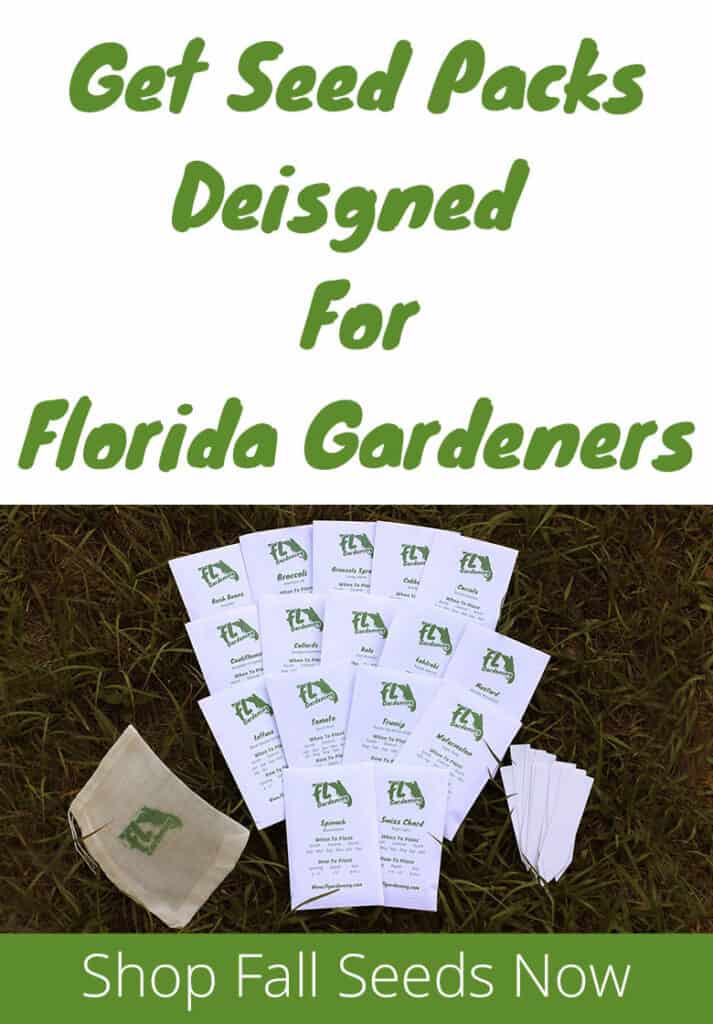
When Do I plant?
In central Florida, the best time to plant tomatoes is once in March and then again in August.
Our planting schedule here in central Florida is different from most other states. Our growing seasons are in the Fall and spring. Not so much the summer like the rest of the United States.
You can grow certain varieties of tomatoes in the summer but it’s just easier to grow them in our spring and fall.
You don’t have to deal with the hellish like heat and midday downpours.
What varieties of tomato can I grow in central Florida?
There are a number of Florida friendly varieties. Deciding which one to grow is as simple as asking yourself do I want large or small tomatoes
and
how much room am I working with?
Some tomatoes will continue to grow WILD, almost like they are a weed. (This has been my Everglades tomato experience.)
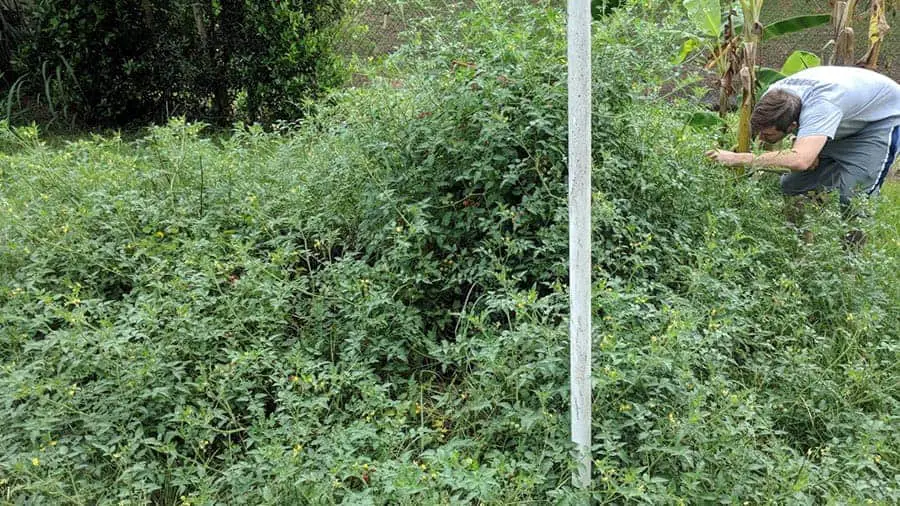
The plants themselves can be 6 feet tall and 10 feet wide(some people have even had tomato plants as big as 12 feet tall).
Tomatoes have an extra classification. They are either determinate or indeterminate.
Determinate type tomatoes will grow to a determined size. Indeterminate varieties will continue to grow until killed.
Either by your hands, disease, thirst, frost or eaten alive by pests.
Having a predetermined size is nice for planning and super helpful to porch/patio growers.
- Indeterminate (Large Fruit): Better Boy, Bonnie’s Best, Striped Cavern
- Indeterminate (Small Fruit): Everglades(summer friendly), Husky Cherry, Sweet 100(Summer friendly),
- Determinate(Large Fruit): Celebrity, Tasti-Lee
- Determinate(Small Fruit): Floragold
- Dwarf Varieties: Patio, Small Fry, Tiny Tim
Where do I plant my tomato in Central Florida?
Make sure to rotate your veggies. What I mean when I say that is to not plant tomatoes(or really anything in the nightshade Family in the same spot).
This seems to make your job harder. When planted this way your veggies are usually weaker and more vulnerable to pest attacks.
Tomatoes need at least 8 hours of sun if you want to have a successful harvest.
I’ve found that a spot that gets lots of early morning and afternoon sun to be ideal. My plants seem to like the early rays better than the late afternoon ones.
It’s also helpful to plant near a water source. It’s not 100% percent necessary.
But it does get old, real fast, having to carry a watering can out there every. single. day.
What do I plant my tomato in?
Your decision should be based on how much room you are working with.
And this should be based on what area you have that gets at least 8 hours of sun.
If you have a backyard that gets at least that, a raised bed is a great option.
If you are working with a small patio that gets at least 8 hours of sun, you can certainly grow tomatoes in containers.
A deep, 24-inch pot is a good choice. But if you’re on a budget, I’ve seen people use 5-gallon buckets with holes drilled in the bottom.
I don’t trust infomercials so I won’t suggest the topsy-turvy.
Do I need to Stake my tomatoes?
Tomatoes usually do need some kind of support. You can grow tomatoes unsupported, but the tomato will sprawl out and lay on the ground. This means more fruit on the ground and fewer leaves exposed to the sun. Neither of which is best for the plant.
Staked tomatoes are healthier, better-producing plants.
The easiest way to stake tomatoes plants is by using a tomato cage.
The best one that I’ve used is this one, with four panels that you can mold around the plant.
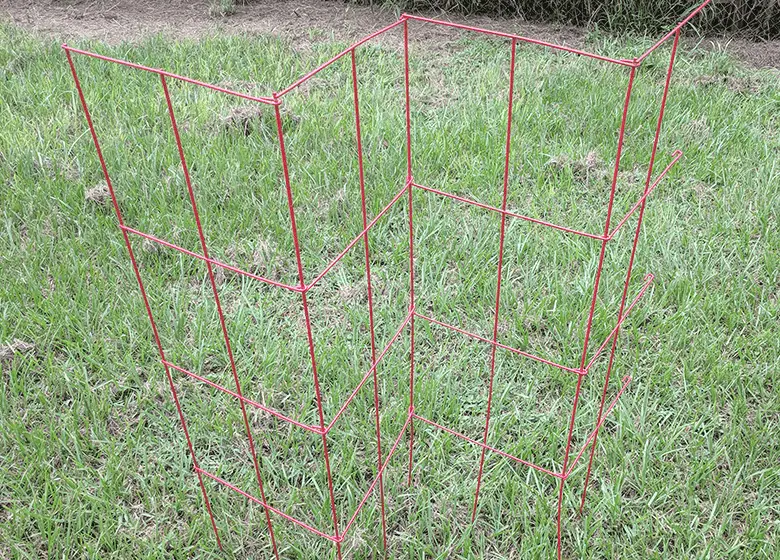
I found this guy at Walmart but you can get them on Amazon too(check price).
What kind of soil do I need?
Tomatoes prefer a soil that is rich in compost and organic matter. They will not stand soil that is soggy or wet so make sure your soil has good drainage.
Tomatoes can live in sandy Florida soils but won’t thrive. Their roots prefer to be constantly moist, but not soaked.
They seem like picky plants but really this isn’t that hard to achieve if you have a good mix.
I really like using this soil mixture:
- ½ peat moss
- ½ compost
- Worm castings
- Fungi additive to create an internet of nutrients, making them easily available to your plants.
It’s also helpful if you add a layer of mulch to your soil.
You don’t even have to buy mulch, you can rake some leaves up and throw them in there if you want.
Or take some leaves off your neighbor’s hands.
Mulch can be anything as long as it’s organic material and helps your soil retain moisture.
How do I water tomatoes?
Not only does a good soil structure help with the perfect amount of water retention but it makes it easier to keep your tomatoes on a healthy watering schedule.
The easiest way to tell if your toms need a drink is to poke your finger in the dirt.
Give them a drink if the top 1-2 inches of soil is dry.
Tomatoes will also show signs of drought stress by looking all droopy.
If your plants are in containers or shallow beds that receive 8+ hours of sun, watering twice a day is not uncommon.
Best fertilizer for tomatoes
Tomatoes are heavy feeders and need plenty of fertilizer to keep them pumping out those juicy vegetables(technically fruits).
Since tomatoes are fruit producing veggies (You don’t eat the green leaves) your fertilizer should not be as nitrogen focused.
Nitrogen, the N to the N-P-K value, Is used by the plant to produce green leafy growth.
Phosphorus, the P to the N-P-K value, is used to flower and set fruit by the plant.
Potassium, the K, is used for a lot of things by the plant so it’s good for overall health.
A good tomato fertilizer would be something like Tomato-tone(Check price on Amazon) which is a 2-4-6.
Tomato-tone also has an extra boost of calcium, which is another important ingredient to plant health and specifically helps tomatoes fight off blossom end rot.
I usually don’t use liquid fertilizers but there are some good ones out there for tomatoes. Fox farm 6-4-4 (Check price on Amazon) is a great option that many people have reported success with.
How to apply fertilizer for tomatoes
If you choose tomato-tone or any other granular fertilizer, It’s good to mix some into the dirt before planting. Always follow the instructions listed on the product, but I mix about 3 tablespoons of tomato-tone per plant into the soil before planting.
I apply more fertilizer every 2 weeks, using 3 tablespoons per plant.
I just sprinkle some around that plant making sure to leave a small gap in between the fertilizer and the plant’s stem.
If the fertilizer stays in constant contact with the stem of your plant, it can cause damage to your plant.
If you choose a liquid fertilizer you can spray it on to your plant’s leaves and also water the plant with it too. Fox Farm 6-4-4 recommends mixing 2-3 teaspoons per gallon of water and applying weekly.
Common pests that attack tomatoes in central Florida
Have you ever found those alien looking green worms on your plants that are devouring your tomato’s foliage? With their pointy butt stingers and green camouflage, the tomato hornworm will feast on your plant’s leaves, some literally eating themselves to death. Swear I’ve seen it.
they are monsters.
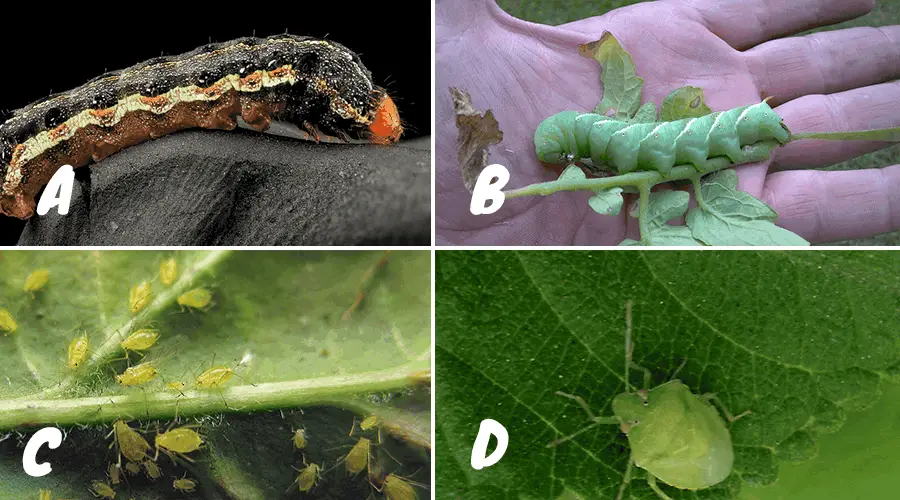
Here are some other common tomato pests and how to handle them:
- Hornworm: A thick bright green caterpillar with black and white accents. They will eat your tomato’s leaves until there are none left. These alien-looking caterpillars actually turn into beautiful sphinx moths. Control: B.T. (Thuricide) is an effective chemical control. However, plants like catnip and basil can be planted to attract predators of the hornworm.
- Aphids: Usually cover the bottoms of leaves and they look like little yellowish green bumps. They damage your plant by piercing it with their pointy mouths and sucking your plant’s juices. They are kind of like vampires. Aphids are especially dangerous because they can easily spread viruses from one plant to another. Control: Aphids have a soft body so they are easily killed by oil-based sprays and insecticidal soaps. I’ve found neem oil to be an effective treatment. Re-apply once a week until aphids are gone. Black-eyed Susan is the most commonly grown plant from the ‘rudbekia’ species and attracts aphid predators, as do the other plants in the species.
- Stink Bugs: Just like aphids, stink bugs damage your plant with their stupid pointy mouths. Stink bugs are also closely related to leaf-footed bugs as well. They both damage your plant in the same way. These bugs go after your fruit though, instead of just sticking to the leaves like aphids. By piercing your fruit this allows entry for other bacteria to come on into your food and start chilling. Setting up a base camp, spreading out everywhere. Control: Neem oil is also a great treatment. You may be able to just hand pick the bugs off your plant if you’re not dealing with an infestation. Sage is a common plant that attracts many stink bug predators.
- Whitefly: They look just how they sound, like tiny little white flies. They are usually found hanging out underneath your leaves. They harm your plants by excreting honeydew, which is a sugary liquid that the bugs produce. This invites sooty mold to grow on your plant which blocks sunlight from reaching your plant’s leaves. Control: Neem oil (once again) is a cold-blooded killer of whiteflies. Lace Bugs and ladybugs are common whitefly predators which are two bugs that also love sage.
- Tomato fruitworm: A brownish tan body with striping and a red/orange head. They are mostly found feeding on your matoes. They like to dig a hole, right into the side of them. Control: B.T.(Thuricide) will kill these worms as well.
Common Tomato Diseases
It’s hard to watch a tomato plant die of a disease. They can strike at any time. The most heartbreaking is right before you’re getting ready to harvest.
The best way to prevent a disease from happening is by choosing disease-resistant varieties. On many packages of tomatoes, you may see the letters VFN, or some combination of them. V stands for Verticillium wilt, F stands for Fusarium wilt and N stand for nematodes. When a seed is labeled VFN that means it is resistant to all three of those things.
Other common tomato viruses are:
- Blossom end rot
- Buckeyed fruit rot
- Early Blight
- Fusarium wilt
- Gray mold
- Late Blight
- Leaf mold
- Pythium stem rot
- Septoria leaf spot
- Verticillium wilt
A good bacterial fungicide is called Serenade(check price on Amazon) but this isn’t the only one that will work.
There are plenty of others out there.
It’s a good idea to spray your plants weekly once established even if you don’t see signs of disease. Prevention is way easier than having to deal with these diseases later. I can’t tell you how many plants I’ve had killed by this issue. It took me many a season to learn to just spray my tomatoes before seeing signs of disease.
Growing Tomatoes In Central Florida
- Plant your tomatoes in March and in August
- They must get at least 8 hours of sunlight.
- Choose the variety of tomato based on the amount of space(with good sunlight) you have and if you want a large or small tomato fruit.
- Staked tomatoes are healthier tomatoes.
- Tomatoes prefer a soil that has good airflow and drainage but stays moist.
- Water whenever the top 1-2 inches of soil is dry.
- Fertilize with tomato-tone or Fox farm, they both how low levels of nitrogen and will help your tomatoes thrive.
- Keep an eye out for pests and diseases. Prevention is best practice. Spray before seeing signs of bugs or disease. A rotation of neem oil and a fungicide is helpful. As is companion plants.
